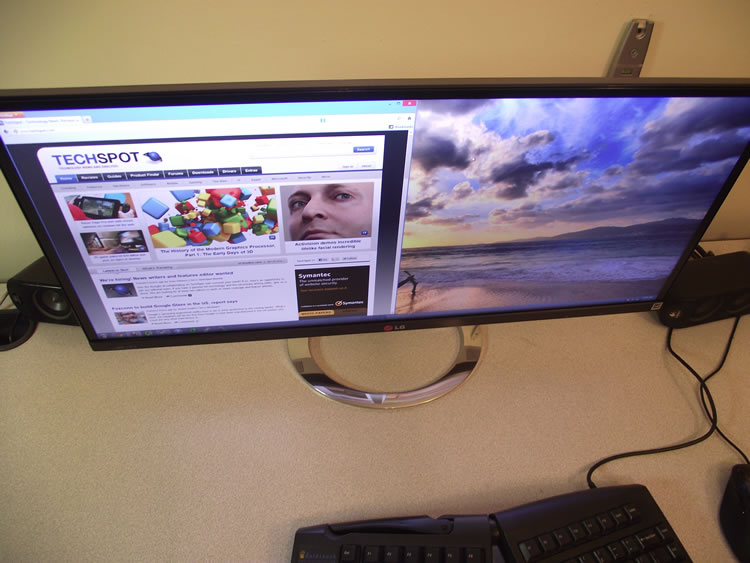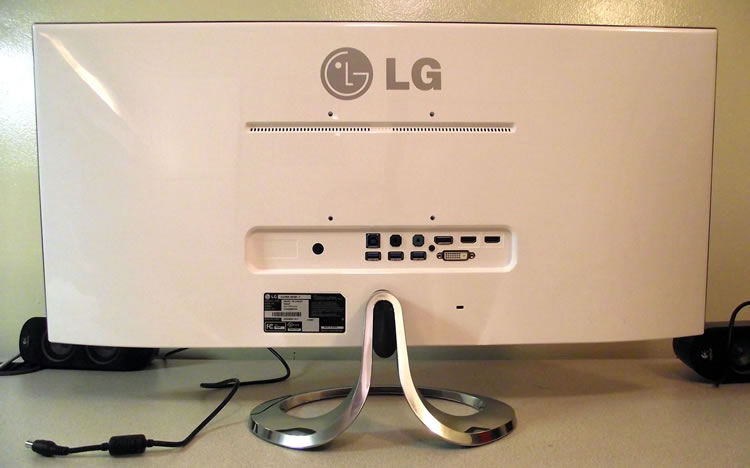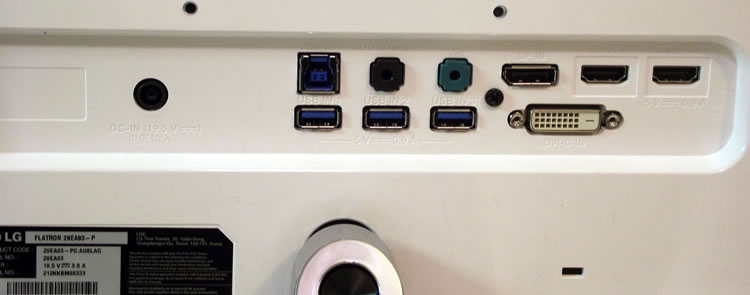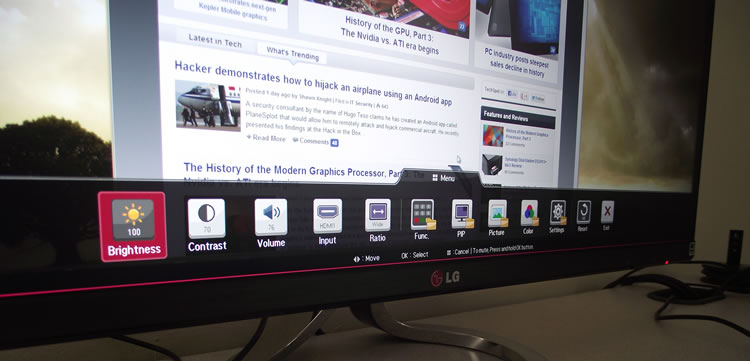The Flatron 29EA93-P is LG's first entry into the still nascent category of ultra-wide consumer displays. There remain few options to compete against the 29EA93's expansive 21:9 aspect ratio (16:9 is typical). However, LG, Dell and a few others ostensibly believe there's a market for ultra-wides and I'll admit – I think they're right.
While the 29EA93 seems suitably equipped to watch movies, how does it fare against other types of computer use? Could it possibly be a worthy replacement for your trusty dual-monitor setup? Does the display's quality, features and novelty justify its $699 street price? Those are some of the questions I'll be exploring.
When 4:3 displays (e.g. 1600 x 1200) gave way to 16:10 screens (e.g. 1920 x 1200), the event was schismatic in terms of consumer preference. Professionals sometimes favored the aging 4:3 standard for its potentially superior vertical real estate – a particularly useful thing for vertically organized content like word processing and websites. Meanwhile, gamers, videophiles and most other consumers were seduced by the benefits of wider displays, as they were perfect for watching movies and monitoring your periphery in FPS games.
When 16:9 (e.g. 1920 x 1080) hit the scene though, computer-savvy consumers were left scratching their collective noggins. The initial shift to wide screens had already limited vertical real-estate, so why narrow it even more? The fast-paced adoption of high-def standards (720p and 1080p) are mostly at fault as manufacturers built their displays around HD video standards. To the chagrin of some though, 16:9 is now by far the most ubiquitous widescreen format.
That understanding brings us back to the 29EA93. With its truly ultra-wide aspect ratio of 21:9, LG delivers 2560 x 1080 pixels in a 29-inch package. It's an impressively wide display – but obviously not wide enough to fully replace two side-by-side 1080p (16:9) monitors. Why then, should any company settle upon a seemingly arbitrary aspect ratio of 21:9? The short answer is: movies.
When it comes to films, 16:9 has been a very popular aspect ratio. Meanwhile, 720p-based and 1080p (16:9) displays have pushed their elder 4:3 progenitor into extinction. These days though, Panavision-inspired cinematographers are cranking out films with ARs north of 2.35:1 (i.e. 21.51:9). This makes 21:9 just about right for watching super-wide flicks without the necessity for visual tricks like cropping, letterboxing or anamorphics. In theory (and in practice, as it turns out), the 29EA93 is perfectly suited for watching HD movies.
Build-quality, aesthetics
While unboxing and setting up our 29EA93, I developed a positive opinion of its build quality. It's clear LG spent time attending to physical details. The result is an attractive, solid feeling product with a comforting (but hopefully unnecessary) three-year warranty.
The chrome-like finish found on its base is actually plastic; however, the stand as a whole is solid and rigid. The stand doesn't snap into but screws into the monitor's frame; have your phillips screwdriver handy, by the way.
For anyone who prefers to mount their monitor to the wall or elsewhere though, the 29EA93's got you covered. The display sports VESA MIS-D (100 mm) mounting holes.
The inclusion of a power brick may be unwelcome news for some, but I consider it a nice touch in terms of quality. Consider this: it's far simpler to replace an external power supply than an internal one. If the power brick ever fails, it will be a quick and cheap fix. It shows LG is thinking. Alternatively, Dell, HP and Asus are all notable brands who've all opted for internal power supplies on their high-end monitor offerings. Just one more thing to consider.
Inside the box, we found one dual DVI-D cable, one MHL cable (for tablets, smartphones), one 3.5mm audio cable, and one A-B USB 3.0 cable. the aforementioned power supply and cord. Absent from the box are, most notably, HDMI and DisplayPort cables.
Ports
The 29EA93 boasts a thorough variety of ports sans VGA. Inputs found on the monitor include: 1 x DisplayPort, 1 x HDMI, 1 x HDMI/MHL, 1 x DVI-D, 3 x USB 3.0 inputs and a jack for 3.5 mm audio. For outputs, we have 1 x USB 3.0 and a single 3.5 mm audio (headphone jack). I'm unaccustomed to seeing high-end monitors without a VGA port, but it is certainly a forgivable omission these days.
Those three USB 3.0 inputs serve as a USB 3.0 hub, which is always a welcome addition.
Ports are recessed in the rear and allow for no-nonsense, 90-degree cable insertion. There's no need to flip the monitor over or to remove concealment panels to access the ports
Controls
The 29EA93's controls are touch-sensitive and located underneath the bottom right of its bezel. There are buttons for the OSD (on-screen display) menu, volume up/down, selection and power.
Although monitor OSDs are typically horrendous, this Flatron boasts a refreshing OSD: it's intuitive, packed with fine-tuning adjustments and even sports a polished look. Inside the OSD, you'll find a rich assortment of options and features, including Picture-in-Picture, 6-color calibration, automatic color calibration (when coupled with compatible hardware), aspect ratio selections and a power LED toggle. The 29EA93's OSD also includes functions for adjusting black-level and response times (more on this later).
Sound
As expected, the 29EA93's built-in pair of tinny-sounding speakers are essentially devoid of bass and warmth. However, despite its absence of audio fidelity, the 29EA93 gets relatively loud. While the integrated speakers won't produce sparkling highs or rumbling lows, the sound it does muster can easily be heard from across the room. Anything beyond office work though will warrant a separate set of speakers.





